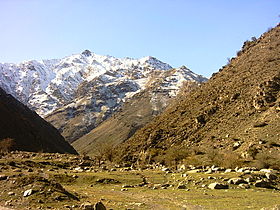Alam-Kuh
| ʿAlam-Kūh | |
|---|---|
| Kuhha-ye Alborz | |
 | |
| Highest point | |
| Elevation | 4,850 m (15,910 ft)[1] |
| Prominence | 1,827 m (5,994 ft)[1] |
| Listing | Ultra |
| Coordinates | 36°22′32.65″N50°57′41.31″E/ 36.3757361°N 50.9614750°E[1] |
| Geography | |
| Location | Mazandaran,Iran |
| Parent range | Alborz |
| Climbing | |
| First ascent | 1902 byAlfredandJoseph Bornmüller |
| Easiest route | rock, snow, ice |
Alam-Kūh(Persian:علمکوه;also:Alam Kooh) –Mount Alam– is a mountain inAlborzmountain rangein northernIran,MazandaranProvince, forming a peak ofTakht-e Suleyman Massif.It is located inKelardasht DistrictofMazandaranProvince. With an elevation of 4,828 meters, it is the second-highest peak in Iran afterMount Damavand.[2]
Climbing history[edit]

The first recorded ascent of the peak was made from Hazarchal over the south face by the German Bornmüller brothers during their six-month botanical exploration of the Alborz in 1902.[3][4]
Douglas Busk,a British mountaineer, climbed Alam-Kuh via the east ridge in 1933 and again in 1934 from over the west ridge.[5]
The 800 m high, steep granite north face provides some of the most difficult and challengingmountaineeringroutes in the country and the climbs rank alongside major climbing routes in the EuropeanAlps.In addition to local climbers, the north face attracts European climbing teams. The first known ascent from the north was by a German party (Gorter/Steinauer) in 1936 via the northwest ridge.[6]
2004 earthquake[edit]
Most of the fixed ropes were severely damaged during a major6.3 magnitude earthquake[7]and consequent rockfall in 2004. The mountain was closed to climbers for some months because of the hazard of rockfall and loose cables.
Terrain and approach[edit]
The mountain range supports permanent snow and glaciers.
Location[edit]
| Map of centralAlborz | Peaks: | 1Alam-Kuh |
|---|---|---|
 −25 to 500 m (−82 to 1,640 ft) 500 to 1,500 m (1,600 to 4,900 ft) 1,500 to 2,500 m (4,900 to 8,200 ft) 2,500 to 3,500 m (8,200 to 11,500 ft) 3,500 to 4,500 m (11,500 to 14,800 ft) 4,500 to 5,610 m (14,760 to 18,410 ft) |
2Azad Kuh | 3Damavand |
| 4Do Berar | 5Do Khaharan | |
| 6Ghal'eh Gardan | 7Gorg | |
| 8Kholeno | 9Mehr Chal | |
| 10Mishineh Marg | 11Naz | |
| 12Shah Alborz | 13Sialan | |
| 14Tochal | 15Varavašt | |
| Rivers: | 0 | |
| 1Alamut | 2Chalus | |
| 3Do Hezar | 4Haraz | |
| 5Jajrood | 6Karaj | |
| 7Kojoor | 8Lar | |
| 9Noor | 10Sardab | |
| 11Seh Hazar | 12Shahrood | |
| Cities: | 1Amol | |
| 2Chalus | 3Karaj | |
| Other: | DDizin | |
| EEmamzadeh Hashem | KKandovan Tunnel | |
| *Latyan Dam | **Lar Dam |
See also[edit]
References[edit]
- ^abc"Iran: 54 Mountain Summits with Prominence of 1,500 meters or greater"Listed here as "Kuhha-ye Alborz". Peaklist.org. Retrieved 2012-02-25.
- ^Sources differ on the height of Alam Kuh. Due to its elevation being very close to that of Sabalan, either of these peaks may be variously listed as either the second or third highest mountain in Iran. Some sources give a significantly higher elevation for Alam Kuh of 4850 m. However, more reliable sources such asPeaklist(Alam Kuh has listed here as "Kuhha-ye Alborz" ) state an elevation of 4805 m based on Soviet topographic maps and modernSRTMdata. This data supports Alam Kuh as the second highest peak in Iran.
- ^J. Bornmüller,Beiträge zur Flora der Elbursgebirge Nord-Persiens,1908
- ^J.G.R. Harding,Cambridge Expedition, 1956, to the Elburz Mountains, Iran,The Himalayan Journal, Vol 20
- ^D.L. Busk,Climbing in the Takht-i-Suleiman Group, N. Persia:The Alpine Journal, v. 47, p. 299–309 (1935).
- ^D.L. Busk,The German expedition in the Elburz Range, N. Persia:The Alpine Journal, v. 49, p. 245-247 (1937).
- ^"Deadly earthquake rocks Iran"Archived2012-09-24 at theWayback MachineCNN. Retrieved 2012-02-25.
External links[edit]
- "Alam Kuh, Iran" on Peakbagger
- SummitPost website
- "Alam-Kuh".Peakware.Archived fromthe originalon 2016-03-04.
- "Iran: Alam Kuh" in The American Alpine Journal, 2002

